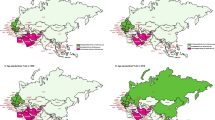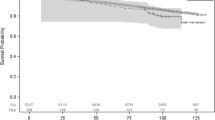Abstract
Purpose
As the epidemiological and burden trends of glaucoma are changing, it is extremely necessary to re-investigate geographical differences and trends. Here we use data from the 2019 Global burden of Disease, which aims to report the prevalence and disability-adjusted life years of glaucoma injury to assess the latest epidemiological models and trends from 1990 to 2019.
Method
Annual case numbers, age-standardized rates of prevalence, DALYs, and their estimated annual percentage changes (EAPCs) for glaucoma between 1990 and 2019 were derived from the GBD 2019 study. The relationship between glaucoma disease burden and social demographic index (SDI) was also investigated in this study.
Results
In 2019, there were 7.47 million prevalent cases and 0.75 million DALYs cases, which increased by 92.53% and 69.23% compared with 1990 respectively. The global age-standardized rate of prevalence (ASPR) and age-standardized rate of DALYs (ASDR) decreased during 1990–2019 (EAPC = − 0.55 and − 1, respectively). In 2019, the highest ASPR and ASDR of Glaucoma were all observed in Mali, whereas the lowest occurred in Taiwan (Province of China). In terms of gender, males were more likely to suffer from glaucoma than females, especially the elderly.
Conclusions
The global prevalence and DALYs of glaucoma had an absolute increase during the past 30 years. The disease burden caused by glaucoma is closely related to socioeconomic level, age, gender, and other factors, and these findings provide a basis for policymakers from the perspective of social management.




Similar content being viewed by others
Data availability
This study comes from a public database (https://ghdx.healthdata.org/), and all access does not require any permissions.
References
Jayaram H, Kolko M, Friedman DS et al (2023) Glaucoma: now and beyond. Lancet 402:1788–1801
Razeghinejad R, Lin MM, Lee D et al (2020) Pathophysiology and management of glaucoma and ocular hypertension related to trauma. Surv Ophthalmol 65:530–547
Stein JD, Khawaja AP, Weizer JS (2021) Glaucoma in adults-screening, diagnosis, and management: a review. JAMA 325:164–174
Kaplan RI, De Moraes CG, Cioffi GA et al (2015) Comparative cost-effectiveness of the baerveldt implant, trabeculectomy with mitomycin, and medical treatment. JAMA Ophthalmol 133:560–567
GBD 2019 Viewpoint Collaborators (2020) Five insights from the Global Burden of Disease Study 2019. Lancet 396:1135–1159
Zou M, Zhang Y, Chen A et al (2021) Variations and trends in global disease burden of age-related macular degeneration: 1990–2017. Acta Ophthalmol 99:e330–e335
GBD 2016 DALYs and HALE Collaborators (2017) Global, regional, and national disability-adjusted life-years (DALYs) for 333 diseases and injuries and healthy life expectancy (HALE) for 195 countries and territories, 1990–2016: a systematic analysis for the Global Burden of Disease Study 2016. Lancet 390:1260–1344
Lin Y, Jiang B, Cai Y et al (2023) The global burden of Glaucoma: findings from the Global Burden of Disease 2019 study and predictions by Bayesian age-period-cohort analysis. J Clin Med 12:1828
Sun H, Wang G, Feng Q et al (2023) Polymer-based self-assembled drug delivery systems for glaucoma treatment: design strategies and recent advances. Polymers (Basel) 15:4466
Mensah GA, Roth GA, Fuster V (2019) The global burden of cardiovascular diseases and risk factors: 2020 and beyond. J Am Coll Cardiol 74:2529–2532
** LJ, Lamster IB, Greenspan JS et al (2016) Global burden of oral diseases: emerging concepts, management and interplay with systemic health. Oral Dis 22:609–619
Yang X, Zhang T, Zhang Y et al (2021) Global burden of COPD attributable to ambient PM2.5 in 204 countries and territories, 1990 to 2019: a systematic analysis for the Global Burden of Disease Study 2019. Sci Total Environ 796:148819
Cohen SS, Bylsma LC, Movva N et al (2022) Theoretical attributable risk analysis and disability adjusted life years (DALYs) based on increased dairy consumption. BMC Public Health 22:1625
GBD 2019 Healthcare Access and Quality Collaborators (2022) Assessing performance of the healthcare access and quality index, overall and by select age groups, for 204 countries and territories, 1990–2019: a systematic analysis from the Global Burden of Disease Study 2019. Lancet Glob Health 10:e1715–e1743
Karamitanha F, Ahmadi F, Fallahabadi H (2023) Difference between various countries in mortality and incidence rate of the atrial fibrillation based on human development index in worldwide: data from global burden of disease 2010–2019. Curr Probl Cardiol 48:101438
Kyari F, Adekoya B, Abdull MM et al (2018) The current status of glaucoma and glaucoma care in Sub-Saharan Africa. Asia Pac J Ophthalmol (Phila) 7:375–386
Siegfried CJ, Shui YB, Bai F et al (2015) Central corneal thickness correlates with oxygen levels in the human anterior chamber angle. Am J Ophthalmol 159:457-462.e451
Tham YC, Li X, Wong TY et al (2014) Global prevalence of glaucoma and projections of glaucoma burden through 2040: a systematic review and meta-analysis. Ophthalmology 121:2081–2090
Preussner PR, Grossmann A, Ngounou F et al (2009) Glaucoma screening in western Cameroon. Graefes Arch Clin Exp Ophthalmol 247:1671–1675
Dai J, Suo L, **an H et al (2023) Investigating the impact of Sun/UV protection and ease of skin tanning on the risk of Pseudoexfoliation glaucoma: a Mendelian randomization study. Invest Ophthalmol Vis Sci 64:4
Aburto JM, Villavicencio F, Basellini U et al (2020) Dynamics of life expectancy and life span equality. Proc Natl Acad Sci USA 117:5250–5259
Pelletier AL, Rojas-Roldan L, Coffin J (2016) Vision loss in older adults. Am Fam Physician 94:219–226
Murayama Y, Yamazaki S, Hasebe M et al (2022) Psychological factors that suppress help-seeking among middle-aged and older adults living alone. Int J Environ Res Public Health 19:10620
Amoozgar B, Moghimi S, Han Y et al (2017) An update on therapeutic modalities for the prevention of angle closure glaucoma. Curr Opin Ophthalmol 28:175–180
Tehrani S (2015) Gender difference in the pathophysiology and treatment of glaucoma. Curr Eye Res 40:191–200
Marques AP, Macedo AF, Perelman J et al (2015) Diffusion of anti-VEGF injections in the Portuguese national health system. BMJ Open 5:e009006
Thurecht R, Pelly F (2020) Key factors influencing the food choices of athletes at two distinct major international competitions. Nutrients 12:924
Acknowledgements
The authors thank all members of the IHME, and Bill & Melinda Gates Foundation which support the related GBD 2019 studies.
Funding
This study was supported by the Traditional Chinese Medicine Science and Technology Plan Project of Zhejiang Province (Grant no. 2024ZR029) and the Basic Public Welfare Research Projects of Wenzhou Science and Technology Bureau (Grant no. Y2023210).
Author information
Authors and Affiliations
Contributions
Each author contributed to the design, data collection, analysis, interpretation, drafting, and revision of the paper.
Corresponding author
Ethics declarations
Conflict of interset
All the authors declare that there is no conflict of interest among the researchers.
Ethical approval
Not applicable.
Additional information
Publisher's Note
Springer Nature remains neutral with regard to jurisdictional claims in published maps and institutional affiliations.
Supplementary Information
Below is the link to the electronic supplementary material.
Rights and permissions
Springer Nature or its licensor (e.g. a society or other partner) holds exclusive rights to this article under a publishing agreement with the author(s) or other rightsholder(s); author self-archiving of the accepted manuscript version of this article is solely governed by the terms of such publishing agreement and applicable law.
About this article
Cite this article
Chen, W., Xu, Y., Liu, Z. et al. Global, regional and national burden of Glaucoma: an update analysis from the Global Burden of Disease Study 2019. Int Ophthalmol 44, 234 (2024). https://doi.org/10.1007/s10792-024-03222-6
Received:
Accepted:
Published:
DOI: https://doi.org/10.1007/s10792-024-03222-6




